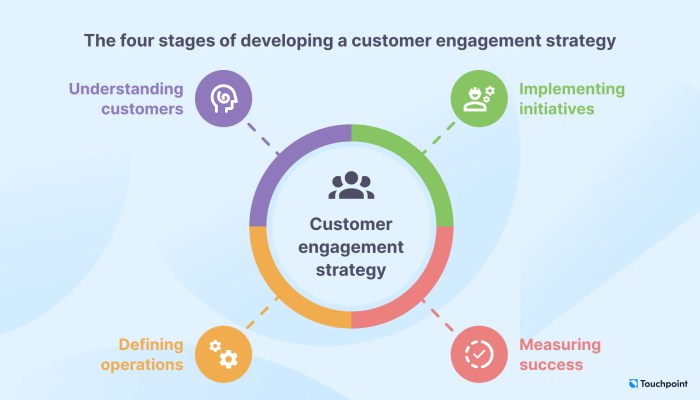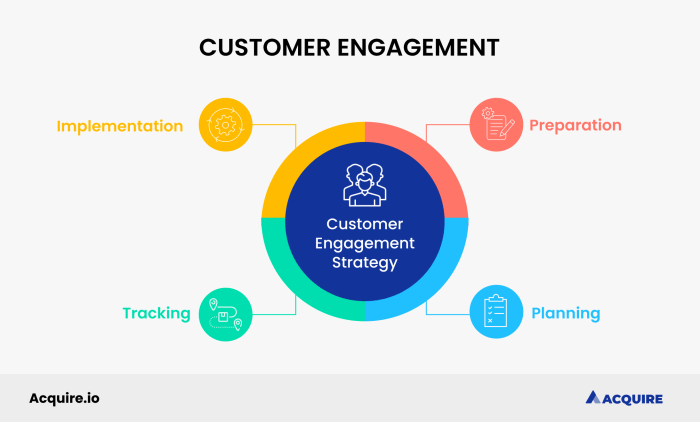Developing a Customer Engagement Strategy sets the stage for business growth and success. Dive into the world of customer engagement strategies with us to uncover the key to connecting with your audience and driving results.
Understanding Customer Engagement
Customer engagement in a business context refers to the ongoing interactions between a company and its customers, with the goal of building a strong relationship and fostering loyalty. It involves creating meaningful connections, providing value, and listening to customer feedback to improve products or services.
Importance of Customer Engagement
Customer engagement is crucial for business success as it helps in retaining existing customers, attracting new ones, and increasing customer lifetime value. By actively engaging with customers, businesses can gain valuable insights, enhance brand loyalty, and ultimately drive revenue growth.
- Responding to customer queries and feedback promptly can improve customer satisfaction and loyalty.
- Personalizing customer interactions based on their preferences and behavior can enhance the overall customer experience.
- Creating engaging content and interactive experiences can help in building a strong emotional connection with customers.
Examples of Successful Customer Engagement Strategies
- Apple’s “Today at Apple” sessions offer customers free workshops and events at Apple stores, creating a sense of community and providing value beyond just selling products.
- Sephora’s Beauty Insider program rewards customers with exclusive perks, personalized recommendations, and special events, encouraging repeat purchases and brand loyalty.
- Starbucks’ mobile app allows customers to order ahead, earn rewards, and customize their drinks, enhancing convenience and personalization for a more engaging experience.
Types of Customer Engagement
When it comes to engaging with customers, there are various strategies that businesses can utilize to connect with their audience and build loyalty. Each type of customer engagement strategy has its own set of pros and cons, depending on the goals and target market of the company.
Social Media
- Pros: Social media platforms allow for direct interaction with customers, quick responses to inquiries, and the ability to showcase products/services in a visually appealing way.
- Cons: Negative feedback can quickly go viral, requiring companies to manage their online reputation carefully.
Email Campaigns
- Pros: Email campaigns can be personalized, targeted, and cost-effective, making them a great way to nurture leads and keep customers informed.
- Cons: Overloading customers with too many emails can lead to unsubscribes and a decrease in engagement.
Loyalty Programs
- Pros: Loyalty programs incentivize repeat business, increase customer retention, and help build brand loyalty over time.
- Cons: Implementing and managing a successful loyalty program can be costly and time-consuming for businesses.
Examples of Effective Implementation
Companies like Starbucks have successfully implemented loyalty programs that reward customers for their repeat purchases, leading to increased customer engagement and brand loyalty. Chipotle’s use of social media to engage with customers through interactive campaigns and user-generated content has also been highly effective in building a strong community around their brand.
Developing a Customer Engagement Strategy

When it comes to developing a customer engagement strategy, there are several key steps that businesses need to consider in order to create a successful plan.
Identify Your Target Audience
In order to create a customer engagement strategy that resonates with your audience, it’s essential to first identify who your target customers are. This involves conducting market research to understand their needs, preferences, and behavior.
Set Clear Objectives
It’s important to establish clear objectives for your customer engagement strategy. Whether it’s increasing brand awareness, driving customer loyalty, or boosting sales, defining your goals will help guide your efforts and measure success.
Choose the Right Channels
Deciding on the channels to engage with your customers is crucial. Whether it’s through social media, email marketing, or in-person interactions, selecting the right platforms that align with your audience’s preferences is key to a successful strategy.
Create Valuable Content
Providing valuable content is essential for engaging customers. Whether it’s informative blog posts, engaging videos, or interactive quizzes, offering content that adds value to your audience will help build relationships and keep them coming back for more.
Measure and Analyze Results
Finally, it’s important to regularly measure and analyze the results of your customer engagement efforts. By tracking key metrics such as engagement rates, conversion rates, and customer satisfaction scores, you can refine your strategy and make improvements over time.
Measuring Customer Engagement

In order to determine the effectiveness of a customer engagement strategy, businesses need to measure key metrics that provide insights into customer interactions and behaviors. Analyzing customer engagement data allows companies to make informed decisions and refine their strategies for better results. There are various tools and software available to help businesses track and monitor customer engagement metrics effectively.
Key Metrics for Measuring Customer Engagement, Developing a Customer Engagement Strategy
- Customer Retention Rate: This metric indicates the percentage of customers who continue to engage with the brand over a specific period of time. A high retention rate signifies strong customer loyalty and satisfaction.
- Customer Lifetime Value (CLV): CLV helps businesses understand the total revenue generated by a customer over their entire relationship with the company. It helps in identifying high-value customers and tailoring engagement strategies accordingly.
- Net Promoter Score (NPS): NPS measures customer loyalty and satisfaction by asking customers how likely they are to recommend the brand to others. It provides valuable insights into customer advocacy and brand perception.
- Engagement Rate: This metric tracks customer interactions with the brand, such as website visits, social media engagement, email opens, and clicks. It helps in evaluating the effectiveness of marketing campaigns and content.
Analyzing Customer Engagement Data
- Segmentation: Divide customers into different segments based on demographics, behavior, or preferences to analyze engagement patterns and tailor strategies accordingly.
- Behavioral Analysis: Monitor customer actions, such as clicks, purchases, and interactions, to identify trends, preferences, and areas for improvement in the engagement strategy.
- Sentiment Analysis: Use tools to analyze customer feedback, reviews, and social media comments to gauge customer sentiment and make adjustments to improve engagement.
Tools for Tracking Customer Engagement Metrics
- Google Analytics: A powerful tool for tracking website traffic, user behavior, and engagement metrics to optimize digital marketing strategies.
- HubSpot: An all-in-one marketing platform that provides insights into customer interactions, lead generation, and campaign performance for better engagement strategies.
- Sprout Social: A social media management tool that helps businesses monitor brand mentions, engagement metrics, and audience insights for effective social media engagement.
